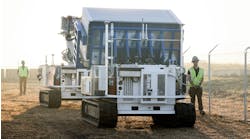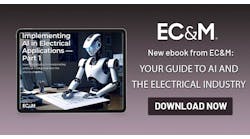As this article was being written — by a real human, not a computer — a meme was making the rounds on social media sites in the construction industry. It shows a downtown job site wrapped with a multi-story billboard that says, “Hey Chat GPT, finish this building . . .”
No, the meme wasn’t created by artificial intelligence (AI) poking fun at itself. It’s a real photo of a real building: the Hotel Keyserlei in Antwerp, Belgium (see Photo). Impact, a European employment agency that specializes in technical and construction jobs, created the billboard in June to capitalize on what some people consider an existential threat not only to the trades but also to humanity itself.
“A big nod to new technologies and in particular AI,” Impact explains on its website. “However the potential of AI is enormous, the skills of crafts(wo)men are irreplaceable. We should think about that more often. Do you want a job in Belgium where you get the appreciation and the respect that you deserve?”
A year ago, that level of awareness and angst didn’t exist, which highlights how quickly the world can change. ChatGPT wasn’t released until Nov. 30, 2022, but within weeks, mainstream media coverage made its promise and peril a hot topic.
In electrical and everywhere else, much of the focus is on the “generative” aspect of ChatGPT and similar AI platforms. This label means they’re capable of taking raw materials such as text and images and fashioning them into things such as the design for an electrical raceway. For instance, Augmenta says its platform can “create fully constructible designs in hours instead of weeks” and “reduce your overall design time by up to 70%.”
“I think in the next 10 years, we’re going to see that generative AI transformed our industry more than we’ve seen any other technology in the past 100 years,” says James Barrett, vice president and chief innovation officer at New York City-based Turner Construction. “I think it’s going to be a radical opportunity for dramatically increasing productivity in our industry.”
Assistants rather than replacements
There are caveats. For example, today’s generative AI tools aren’t capable of creating a complete, ready-to-build design, but rather a solid first draft for humans to vet and refine. The amount of human involvement depends on a wide variety of factors, such as the tool’s capabilities and the type of information it’s fed.
“The [initial] 10%, 20%, 30% is really pretty easy for some of the more advanced AI tools to get,” says John Guilfoyle, chief of technology and innovation at Stanley Consultants, which is using tools such as Transcend. “Then have a human quality check it, and the engineer takes it from there. So we’re not producing finished products with the AI tools. We’re producing sort of early-stage, planning-level-type conceptual designs that our staff can take and run with.”
More design options in less time are among the benefits that Sioux Center, Iowa-based Interstates is seeing from its pilot of Augmenta’s tool.
“We can have 100 and some motors and 100 and some devices, and it’s generating 13 different solutions in less than an hour,” says Josh Gillespie, director of BIM/VDC. “I could put my best team of five people on that, give them all one hour, and we wouldn’t come close to what that’s kicking out for us. So that’s an enormous boost in productivity and efficiency — and also responsiveness to the customer.”
This kind of productivity is a major reason why many people worry that AI will put them out of a job. But at least for the foreseeable future, AI will be limited to the initial grunt work on a project — the kinds of tasks that traditionally are done by junior employees or by veterans who already find it mind-numbingly mundane.
“What we’re looking at is sort of redefining AI to what we call ‘augmented intelligence’ rather than ‘artificial,’ meaning this technology should be used to free up people to [do] what’s really value-added, that humans are good at,” says Turner’s Barrett.
As a result, firms could use AI as a way to attract and retain employees in the highly competitive labor market by offering them tools that free them to focus on more interesting aspects of design.
“We’re trying to find those areas where we’re trying to have humans act like robots and just design robots to do those tasks,” says Dustin Schafer, CTO at Lenexa, Kansas-based Henderson Engineers. “It gives people more opportunities to do the things that people are good at.”
The productivity boost also helps firms compete for clients.
“We can leverage those people across more clients because they’re not doing that routine stuff,” Schafer says. “Increasing efficiency means that you get to do more work for more clients because you can be more aggressive with your price point. So it opens up the market to more opportunities.”
Stanley Consultants began exploring AI in 2019 partly as a way to compete for scarce talent.
“How can we continue to do top-tier work but in a way that doesn’t require us to simply hire more people?” Guilfoyle says. “We’re never not going to try to hire the best people, but we were seeing on the radar there’s a real shortage coming of engineers.”
Electrical contractors also could use AI to expand into design services, thus capturing more revenue from each project. For example, a contractor might have stayed out of design because it couldn’t afford to add enough staff — especially when there’s a chronic shortage. But with generative AI’s productivity boost, it might be able to launch a competitive service with the few it can afford.
“This is a very strong kind of value proposition for smaller contractors or contractors that don’t have design capabilities in-house,” says Francesco Iorio, Augmenta CEO. “They could literally hire one person and [operate] like they had 10. This is also true for smaller contractors that already have one person, but they struggle to hire anyone [else].”
2,000 options, but which one is right?
AI also can help increase client satisfaction by enabling employees to come up with more design choices to save money, speed up construction, or accommodate challenging architectural. For example, the AI could propose a second design that moves a bank of conduit 20 feet, thus eliminating labor costs for elaborate bends or extensive drilling.
“You can test more options,” says Henderson’s Schafer. “One surprising thing we found is that it allows you to give someone else the context of why you think your answer is the best other than just saying, ‘I’ve done this a lot, so this is the right way to do it.’
“If you start to do generative design, you could bring 2,000 options and say: ‘We tried all 2,000 of these, and this one uses the least amount of duct’ or ‘This one is the least labor’ or ‘This one has the least conflicts.’ You can start to put context to why you think it’s the best one. Then it’s way easier to move forward. Designs don’t get challenged because everybody understood how you kind of proved it out.”
In the future, generative AI could further refine those options by leveraging additional data sources, such as each employee’s expertise and pay. But to do that, contractors and design firms will need to compile that kind of nuanced information into a format that AI tools can use.
“It will ignore everything that you don’t put in there, including like this particular journeyman or this particular apprentice is more or less skilled at this particular thing,” Schafer says. “It’s really difficult to predict those kinds of things if you don’t have all that data captured.”
Another future possibility is using application programming interfaces (APIs) so the tool can access vendor and distributor product and pricing databases. This information would free employees from the tedium of tracking down all that information manually and then adding it to each iteration of the AI designs.
Some AI tools have “natural language” or “large language” interfaces, which let users describe something in everyday terms. For example, New York City-based CannonDesign is leveraging this capability in Midjourney to combine images created with Revit and from other sources.
“That’s the biggest time saver right now: being able to do these combos,” says Coffield King, senior lighting designer. “[Suppose you] need a hospital lobby that’s warm, bright colors, double height with connecting stair, and you’re searching for that kind of thing on Pinterest or Google and you’re not finding that image. That’s where you can use the text and just tell it exactly what you want. It does that really well.”
It also turns out that some tools do better with vernacular rather than technical input.
“Someone yesterday said, ‘I need a double-height atrium with wood ceilings and clear stories with sunlight coming in,’” King says. “That prompt right there works great. But if you use contractor or electrical or architectural spec text, it doesn’t work out very well.”
Data security is key
When developing a game plan for implementing or even just piloting AI, data security and privacy should be a top priority. The catch is that AI vendors need as much raw data as possible to continually improve their tools’ ability to make sense of the real world.
The solution is to focus on AI tools that keep confidential company and client data from being shared with the vendor. For example, Overland Park, Kansas-based Black & Veatch is piloting Microsoft’s Azure OpenAI service.
“That allows us to use the ChatGPT model that secures our data and our intellectual property,” says Andrew Scott, chief digital strategist. “It means that our internal data isn’t making it out into the big wide world. That gives us a sense of protection within our organization but also allows us to have the benefits of using a model that is trained globally on massive amounts of data. We have plans to expand that pilot into full general release production within the next quarter.”
Stanley Consultants is avoiding the natural/large language tools for security reasons.
“We are specifically not using ChatGPT because of some of the security issues that platform has,” Guilfoyle says. “We don’t want to give Stanley data to that platform and have it become part of their cloud and part of their model. There are more secure, closed-in technologies that do large language models that we’re looking at using instead. This allows us to feed like all kinds of old proposals, resumes, project descriptions [and other] work we’ve done previously that’s similar.”
Stanley also sees this challenge as an opportunity to gain a competitive edge.
“We’re going to be training those large language models on our own content so that we have much more bespoke tools,” Guilfoyle says.
Data security is another reason for studying generative AI ASAP rather than waiting to see how the industry uses it — and which vendors survive the shakeout that inevitably comes with any red-hot market. For example, when employees are left to explore AI on their own, it can become a “shadow IT” project that escapes company notice until something bad happens, like a leak or hack of proprietary information. Black & Veatch is heading off these kinds of risks by developing policies and best practices that let employees use these bleeding-edge technologies now but with safeguards.
“We’ve set some guidelines [and] given some examples of things that they could use it for and shouldn’t use it for,” Scott says. “People can request access to it through our service management processes, so they have to read and acknowledge the guidelines, along with a quick start guide and FAQ. Then we grant them access.”
Tim Kridel is an independent analyst and freelance writer. He can be reached at [email protected].



